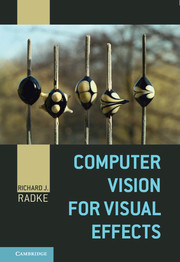Crossref Citations
This Book has been
cited by the following publications. This list is generated based on data provided by Crossref.
Dolinsky, Margaret
McDowall, Ian E.
Steckel, Kayla
and
Whittinghill, David
2014.
Z-depth integration: a new technique for manipulating z-depth properties in composited scenes.
Vol. 9012,
Issue. ,
p.
90120A.
Barber, Alastair
Brown, Matthew
Hogbin, Paul
and
Cosker, Darren
2015.
Inferring changes in intrinsic parameters from motion blur.
Computers & Graphics,
Vol. 52,
Issue. ,
p.
155.
Wu, Ziyan
2016.
Human Re-Identification.
p.
13.
Liu, Yi-Hsin
Ciou, Jian-Jie
Liou, Siou-Hong
and
Chang, Cheng-Yuan
2017.
Design and implement of a multifunctional image keying system.
p.
273.
Pereira, Fabio Irigon
Luft, Joel Augusto
Ilha, Gustavo
and
Susin, Altamiro
2018.
A Novel Resection–Intersection Algorithm With Fast Triangulation Applied to Monocular Visual Odometry.
IEEE Transactions on Intelligent Transportation Systems,
Vol. 19,
Issue. 11,
p.
3584.
Sayers, Dean
Habib, Maged Salim
and
AL-Diri, Bashir
2019.
Intelligent Computing.
Vol. 997,
Issue. ,
p.
1090.
Dumbgen, Frederike
Oeschger, Cynthia
Kolundzija, Mihailo
Scholefield, Adam
Girardin, Emmanuel
Leuenberger, Johan
and
Ayer, Serge
2019.
Multi-Modal Probabilistic Indoor Localization on a Smartphone.
p.
1.
Ajmal, Aisha
Harith-Al-Sahaf
and
Hollitt, Christopher
2020.
Salient Motion Features for Visual Attention Models.
p.
1.
Halmaoui, Houssam
and
Haqiq, Abdelkrim
2021.
Artificial Intelligence and Industrial Applications.
Vol. 1193,
Issue. ,
p.
291.
Halmaoui, Houssam
and
Haqiq, Abdelkrim
2021.
Proceedings of the International Conference on Advanced Intelligent Systems and Informatics 2020.
Vol. 1261,
Issue. ,
p.
79.
Segre, Enrico
2022.
Image Warp Preserving Content Intensity.
SIAM Journal on Imaging Sciences,
Vol. 15,
Issue. 4,
p.
1623.





